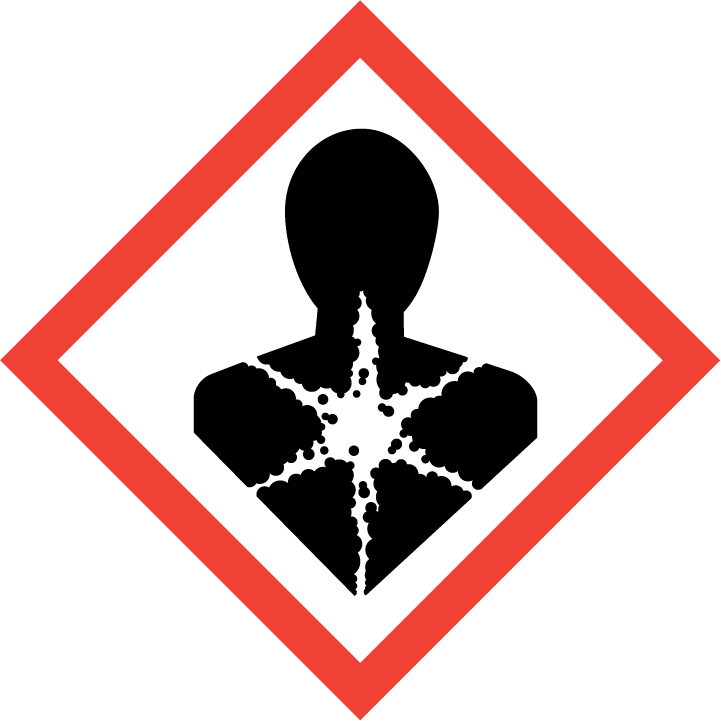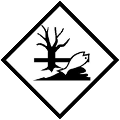SAFETY DATA SHEET
Lowicryl HM23, Initiator J
1. IDENTIFICATION
Product Identifiers
Product Name:
Lowicryl HM23, Initiator J
Other Names:
Not available
Product Number(s):
14360J, EMS14360
CAS Number:
24650-42-8
Recommended use of the chemical and restriction on use
Laboratory chemicals
Company Details
ProSciTech Pty Ltd
11 Carlton Street
KIRWAN QLD 4817
Australia(07) 4773 9444www.proscitech.com
11 Carlton Street
KIRWAN QLD 4817
Australia(07) 4773 9444www.proscitech.com
Emergency Contact Details
ProSciTech Pty Ltd
11 Carlton Street
KIRWAN QLD 4817
Australia(07) 4773 9444www.proscitech.com
11 Carlton Street
KIRWAN QLD 4817
Australia(07) 4773 9444www.proscitech.com
2. HAZARDS IDENTIFICATION
Classification of the substance or mixture
GHS08 Health hazard
Specific Target Organ Toxicity - Repeated Exposure 2 H373 May cause damage to organs through prolonged or repeated exposure.
GHS07
Skin Irritation 2 H315 Causes skin irritation.
Eye Irritation 2A H319 Causes serious eye irritation.
Sensitization - Skin 1 H317 May cause an allergic skin reaction.
Specific Target Organ Toxicity - Repeated Exposure 2 H373 May cause damage to organs through prolonged or repeated exposure.
GHS07
Skin Irritation 2 H315 Causes skin irritation.
Eye Irritation 2A H319 Causes serious eye irritation.
Sensitization - Skin 1 H317 May cause an allergic skin reaction.
Label Elements


Signal Words
Warning
Hazard Statement(s)
Hazard-determining components of labelling:
2,2-Dimethoxy-2-phenylacetophenone
Causes skin irritation.
Causes serious eye irritation.
May cause an allergic skin reaction.
May cause damage to organs through prolonged or repeated exposure.
2,2-Dimethoxy-2-phenylacetophenone
Causes skin irritation.
Causes serious eye irritation.
May cause an allergic skin reaction.
May cause damage to organs through prolonged or repeated exposure.
Precautionary Statement(s)
Do not breathe dust/fume/gas/mist/vapours/spray.
Wash thoroughly after handling.
Contaminated work clothing must not be allowed out of the workplace.
Wear protective gloves/eye protection/face protection.
Wash thoroughly after handling.
Contaminated work clothing must not be allowed out of the workplace.
Wear protective gloves/eye protection/face protection.
Primary route(s) of entry
Not available.
Human Health
Inhalation:
Not available.
Ingestion:
Not available.
Eyes:
Rinse cautiously with water for several minutes. Remove contact lenses if present and easy to do. Continue rinsing. Get medical advice/attention if you feel unwell. If eye irritation persists: Get medical advice/attention.
Skin:
Wash with plenty of water. Take off contaminated clothing and wash it before reuse. If skin irritation or rash occurs: Get medical advice/attention.
Environment
Store in a dry place.
Dispose of contents/container in accordance with local/regional/national/international regulations.
Dispose of contents/container in accordance with local/regional/national/international regulations.
3. COMPOSITION/INFORMATION ON INGREDIENTS
Name
CAS No.
Content (w/w)
Classification
2-Dimethoxy-2-phenyacetophenone
24650-42-8
EC number: 246-386-6
4. FIRST AID MEASURES
Ingestion
If symptoms persist consult doctor.
Inhalation
Supply fresh air and to be sure call for a doctor.
In case of unconsciousness place patient stably in side position for transportation.
In case of unconsciousness place patient stably in side position for transportation.
Skin Contact
Immediately wash with water and soap and rinse thoroughly.
Eye Contact
Rinse opened eye for several minutes under running water. If symptoms persist, consult a doctor.
Other Information
Symptoms of poisoning may even occur after several hours; therefore medical observation for at least 48 hours after the accident.
5. FIREFIGHTING MEASURES
Suitable extinguishing equipment
Use fire fighting measures that suit the environment.
HAZCHEM
No further relevant information available.
Special protective equipment and precautions for fire fighters
6. ACCIDENTAL RELEASE MEASURES
Personal precautions, protective equipment and emergency procedures
Not required.
Environmental precautions
Inform respective authorities in case of seepage into water course or sewage system.
Do not allow to enter sewer/surface or ground water.
Do not allow to enter sewer/surface or ground water.
Methods and materials for containment and clean up
Absorb with liquid-binding material (sand, diatomite, acid binders, universal binders, sawdust).
Dispose contaminated material as waste according to item 13.
Ensure adequate ventilation.
Dispose contaminated material as waste according to item 13.
Ensure adequate ventilation.
7. HANDLING AND STORAGE
Precautions for safe handling
Ensure good ventilation/exhaustion at the workplace.
Prevent formation of aerosols.
Prevent formation of aerosols.
Conditions for safe storage
8. EXPOSURE CONTROLS/PERSONAL PROTECTION
Exposure Standards
Engineering controls
Keep away from foodstuffs, beverages and feed.
Immediately remove all soiled and contaminated clothing.
Wash hands before breaks and at the end of work.
Avoid contact with the eyes and skin.
Immediately remove all soiled and contaminated clothing.
Wash hands before breaks and at the end of work.
Avoid contact with the eyes and skin.
Personal protective equipment
Eye and face protection
Tightly sealed goggles.
Skin protection
Protective gloves. The glove material has to be impermeable and resistant to the product/ the substance/the preparation. Selection of the glove material on consideration of the penetration times, rates of diffusion and the degradation. The exact break through time has to be found out by the manufacturer of the protective gloves and has to be observed.
Body protection
Not available.
Respiratory protection
In case of brief exposure of low pollution use respiratory filter device. In case of intensive or longer exposure use respiratory protective device that is independent of circulating air.
9. PHYSICAL AND CHEMICAL PROPERTIES
General information
Appearance
Colourless solid
Odour
Characteristic
pH
Not determined
Vapour Pressure
Not determined
Density
1.21g/cm³
Boiling Point
Undetermined
Melting Point
68°C
Solubility
Not miscible or difficult to mix.
Specific Gravity of Density
Not available.
Flash Point
Not applicable.
Flammable (Explosive) Limits
Not determined
Ignition Temperature
Not determined
Formula
Not available.
10. STABILITY AND REACTIVITY
Reactivity
No further relevant information available.
Chemical stability
No decomposition if used according to specifications.
Possibility of hazardous reactions
No dangerous reactions known.
Conditions to avoid
No further relevant information available.
Incompatible materials
No further relevant information available.
11. TOXICOLOGICAL INFORMATION
Acute effects
Not available.
Eye contact
Irritating effect.
Skin contact
Irritant to skin and mucous membranes. Sensitization possible through skin contact.
Ingestion
Not available.
Inhalation
Not available.
Toxicity and irritation
Substance is not listed.
12. ECOLOGICAL INFORMATION
Ecotoxicity
Very toxic for fish.
Persistence and degradability
No further relevant information available.
Bioaccumulative potential
No further relevant information available.
Other adverse effects
Water hazard class 2: hazardous for water.
Do not allow product to reach ground water, water course or sewage system.
Danger to drinking water if even small quantities leak into the ground.
Also poisonous for fish and plankton in water bodies.
Very toxic for aquatic organisms.
Do not allow product to reach ground water, water course or sewage system.
Danger to drinking water if even small quantities leak into the ground.
Also poisonous for fish and plankton in water bodies.
Very toxic for aquatic organisms.
13. DISPOSAL CONSIDERATIONS
General information
Must not be disposed of together with household garbage. Do not allow product to reach sewage system.
Disposal must be made according to official regulations.
Disposal must be made according to official regulations.
14. TRANSPORT INFORMATION
ADG label required


HAZCHEM
No further relevant information available.
UN Number
UN3077
Proper shipping name
Environmentally hazardous substance, solid, n.o.s. (2,2-Dimethoxy-2-phenylacetophenone)
Transport hazard class
Class 9 Miscellaneous dangerous substances and articles.
Packing group
III
Environmental hazard
Product contains environmentally hazardous substances: 2,2-Dimethoxy-2-phenylacetophenone
Special marking: Symbol (fish and tree).
Special marking: Symbol (fish and tree).
Special precautions for users
Warning: Miscellaneous dangerous substances and articles.
Hazard identification number (Kemler code): 90
EMS Number: F-A,S-F
Stowage category: A
Stowage Code: SW23 When transported in BK3 bulk container, see 7.6.2.12 and 7.7.39
Hazard identification number (Kemler code): 90
EMS Number: F-A,S-F
Stowage category: A
Stowage Code: SW23 When transported in BK3 bulk container, see 7.6.2.12 and 7.7.39
Additional information
DOT
Quantity limitations:
On passenger aircraft/rail: 400kg
On cargo aircraft only: 400kg
ADR
Excepted quantities (EQ) Code: E1
Maximum net quantity per inner packaging: 30mL
Maximum net quantity per outer packaging: 1000mL
IMDG
Limited quantities (LQ) 5kg
Excepted quantities (EQ) Code: E1
Maximum net quantity per inner packaging: 30mL
Maximum net quantity per outer packaging: 1000ml
Quantity limitations:
On passenger aircraft/rail: 400kg
On cargo aircraft only: 400kg
ADR
Excepted quantities (EQ) Code: E1
Maximum net quantity per inner packaging: 30mL
Maximum net quantity per outer packaging: 1000mL
IMDG
Limited quantities (LQ) 5kg
Excepted quantities (EQ) Code: E1
Maximum net quantity per inner packaging: 30mL
Maximum net quantity per outer packaging: 1000ml
15. REGULATORY INFORMATION
Poisons Schedule Number
Substance is not listed.
Other Information
A Chemical Safety Assessment has not been carried out.
16. OTHER INFORMATION
SDS preparation date
6 April 2023
Comments
This information is based on our present knowledge. However, this shall not constitute a guarantee for any specific product features and shall not establish a legally valid contractual relationship.
This Safety Data Sheet (SDS) has been prepared in compliance with the Preparation of Safety Data Sheets for Hazardous Chemicals Code of Practice February 2016. It is the user's responsibility to determine the suitability of this information for adoption of necessary safety precautions. The information published in this SDS has been compiled from the publications listed in Section 16: to the best of our ability and knowledge these publications are considered accurate. We reserve the right to revise Safety Data Sheets as new information becomes available. Copies may be made for non-profit use.